Best mesh Wi-Fi systems of 2025: say goodbye to Wi-Fi dead zones for good
The best mesh Wi-Fi systems give you a strong wireless signal throughout your entire home

The best mesh Wi-Fi systems are the ultimate upgrade for your home network, especially if you have Wi-Fi dead zones. These multi-piece kits can fill even the largest homes with a strong Wi-Fi signal, whether you’re out in the garage or even in the backyard.
In order to determine which mesh Wi-Fi systems are truly the best, we put them through extensive real-world testing in an actual home. This includes running benchmarks at multiple distances to measure their speed and range as well as seeing how these kits work together when combined into a single network. Plus, we evaluate how well each mesh Wi-Fi system moves data through walls and ceilings.
Based on our extensive benchmarking, the best mesh Wi-Fi system overall is the Netgear Orbi RBE973. This mesh router comes equipped with Wi-Fi 7 for blazing fast speeds and has all the ports you need for multi-gig internet. If you’re on a budget but still want the big speed boost that comes with Wi-Fi 6E, the TP-Link Deco XE75 is a great pick and you also won't have to worry about upgrading anytime soon.
There are lots of other great mesh Wi-Fi systems we recommend for different use cases and homes based on our reviews, including larger, more powerful ones and more compact kits for smaller homes. These are the best mesh Wi-Fi systems you can buy right now.
The quick list

Performance:★★★★☆
Range: ★★★★☆
Value: ★★☆☆☆
This Wi-Fi 7 mesh system delivers blazing fast speeds, comes with a year of built-in security software and has all the ports you’ll need. However, all this doesn't come cheap.

Performance: ★★★★☆
Range: ★★★★☆
Value: ★★★★★
This Wi-Fi 6E mesh system offers great value, comes with built-in security software, has excellent range and is quite fast. However, it isn’t equipped for multi-gig internet.

Performance: ★★★★☆
Range: ★★★★☆
Value: ★★★☆☆
This Wi-Fi 6 mesh system comes with built-in security software, offers excellent performance and has loads of gaming features baked in. However, it only comes in a two-pack and its design won’t fit every home.

Performance: ★★★★☆
Range: ★★★★★
Value: ★★☆☆☆
This Wi-Fi 7 mesh system excels at medium to long distances, comes with plenty of high-speed ports and is really fast up close. However, it still comes at a premium and you’ll have to pay extra for security software.
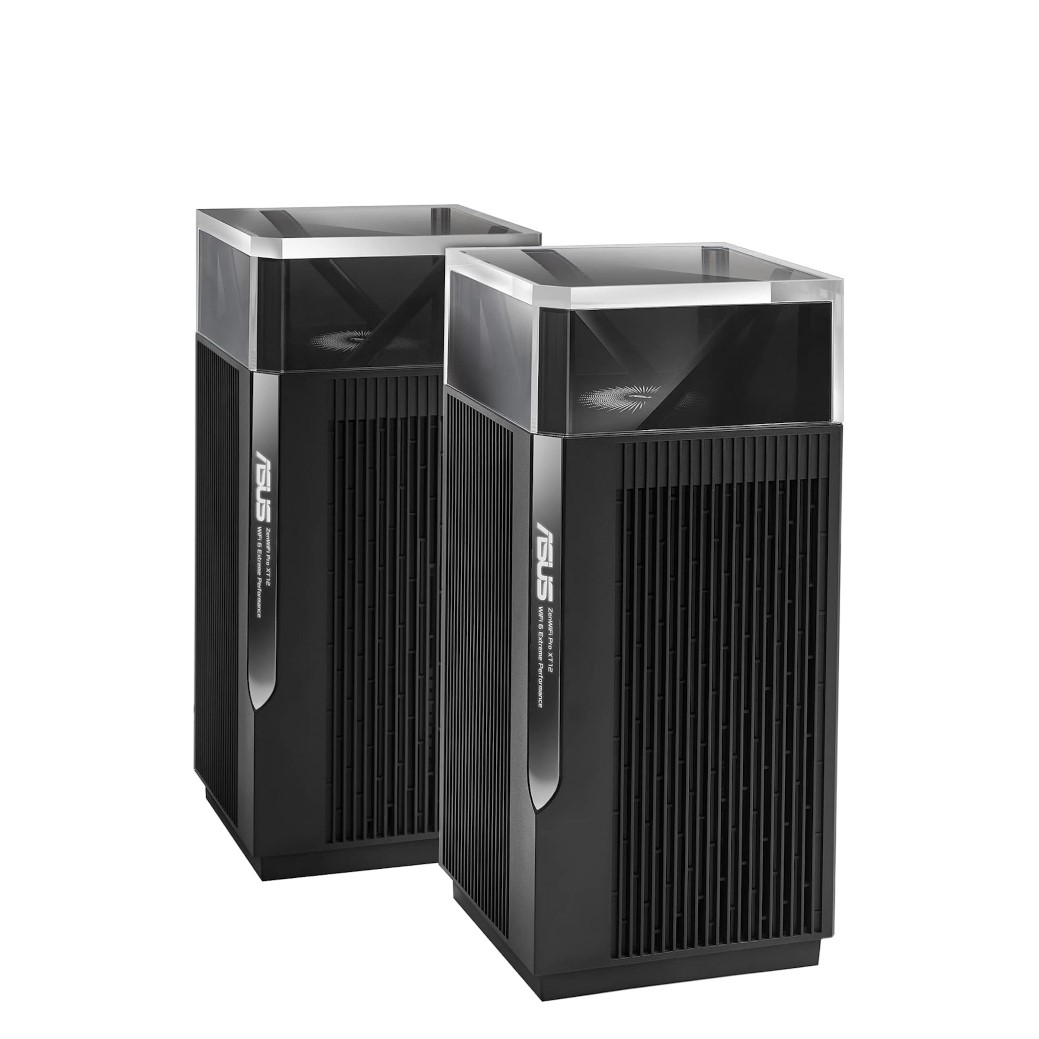
Performance: ★★★★☆
Range: ★★★★★
Value: ★★★☆☆
This Wi-Fi 6E mesh system has a beautiful design, comes with built-in security software and delivers excellent performance up close. It’s only available in a two-pack though and doesn’t offer the fastest speeds possible.

Performance: ★★★★★
Range: ★★★★☆
Value: ★★★☆☆
This Wi-Fi 7 mesh system delivers super fast speeds, has all the ports you need and is perfect for fiber internet. It’s still quite expensive though and there’s not a lot to customize.
Click to view more options...

Performance: ★★★☆☆
Range: ★★★★☆
Value: ★★★★☆
This Wi-Fi 7 mesh system is more affordable, comes with built-in security software and it has a longer three-year warranty. However, it’s not as fast as other Wi-Fi 7 routers and isn’t equipped for multi-gig internet.

Performance: ★★★☆☆
Range: ★★★★☆
Value: ★★★★☆
This dual-band Wi-Fi 7 mesh system gives you access to the latest wireless standard’s best features, comes with built-in security software and is very affordable. However, you don’t get access to the faster 6 GHz band and there are only two downstream Ethernet ports.

Performance: ★★★★☆
Range: ★★★☆☆
Value: ★★★☆☆
This Wi-Fi 6E mesh system is incredibly easy to set up, has great speeds at close distances, can act as a smart home hub and you can even use an Echo Dot with it as a mesh extender. It only has two ports on the back though.
Read more below
The best mesh Wi-Fi systems you can buy today
Why you can trust Tom's Guide
The best mesh Wi Fi system overall


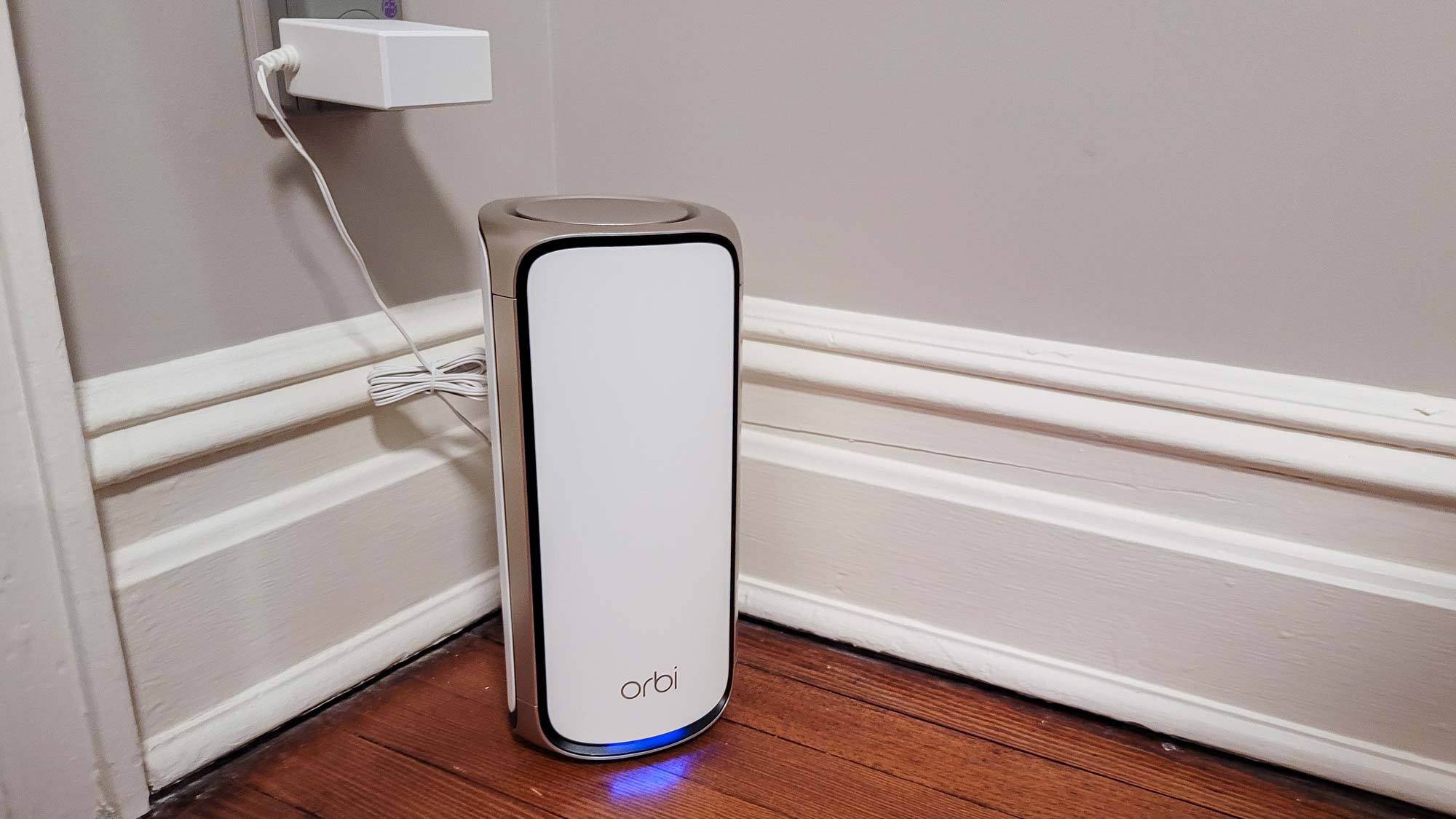
Specifications
Reasons to buy
Reasons to avoid
✅ You have a multi-gig internet plan: The Orbi RBE973 is a great choice for those with multi-gigabit internet plans as it has two 10 Gbps Ethernet ports.
✅ You have a huge house: Each Orbi RBE973 device has a range of 3,300 feet and a three-pack can cover up to 10,0 square feet.
❌ You're on a budget: The Orbi RBE973 is the most expensive Wi-Fi 7 mesh router released to date.
❌ You want free tech support: Netgear only includes 90 days of free tech support. After that, you'll have to pay
The Orbi RBE973 is the best of the best when it comes to Netgear’s mesh routers. This mesh Wi-Fi system comes at a steep cost — $16,99 for a two-pack and $2,299 for a three-pack — but for the price, you’re getting all of the extra features and functionality of Wi-Fi 7 from super fast speeds, wider data channels and multi-link operation which lets you use multiple bands (2.4 Ghz, 5 Ghz and 6 GHz) simultaneously. This is all wrapped up in a brand new design and in our opinion, the Orbi RBE973 looks a whole lot sleeker than Netgear’s previous mesh Wi-Fi systems.
Not too long ago, It used to be a big deal to get gigabit download speeds over Wi-Fi. Well with the Orbi RBE973, we managed to reach download speeds of over 2 gigabits per second (Gbps) in our testing. This was right up next to the router at 15 feet though. Speeds dropped off quickly from there as we moved further away from the router (down to 495 Mbps at 50 feet) but keep in mind, this is a mesh Wi-Fi system after all and you will have either one or two satellites to push a faster wireless signal further. Likewise, switching from the Orbi RBE973’s 6 GHz to its 5 GHz band will also help with range. Still, this mesh router had a total range of 95 feet.
Unlike many of the other mesh Wi-Fi systems on this list, the Orbi RBE973 is a quad-band instead of a tri-band device. This may not seem like that big of a deal but if your home isn’t wired for Ethernet — which it likely isn’t — this can be a game changer. The extra 5 GHz band on the Orbi RBE973 is used for backhaul communication between the main unit which serves as the router which lets you get the most bandwidth possible from this premium mesh router system.
As this is a premium mesh Wi-Fi system after all, it’s fully equipped for more expensive, multi-gig internet plans. Around back, you get a 10 Gbps WAN port to connect to your cable modem and another to connect to your wired devices which is perfect for downloading and sending large files quickly like a game on Steam or a whole season of a TV show. If you don’t plan on upgrading anytime soon and want a futureproof mesh router, the Orbi RBE973 more than fits the bill. However, if you want more than the one-year warranty and 90 days of technical support, you will have to pay Netgear for that.
Read our full Orbi RBE973 review
The best budget mesh Wi Fi system
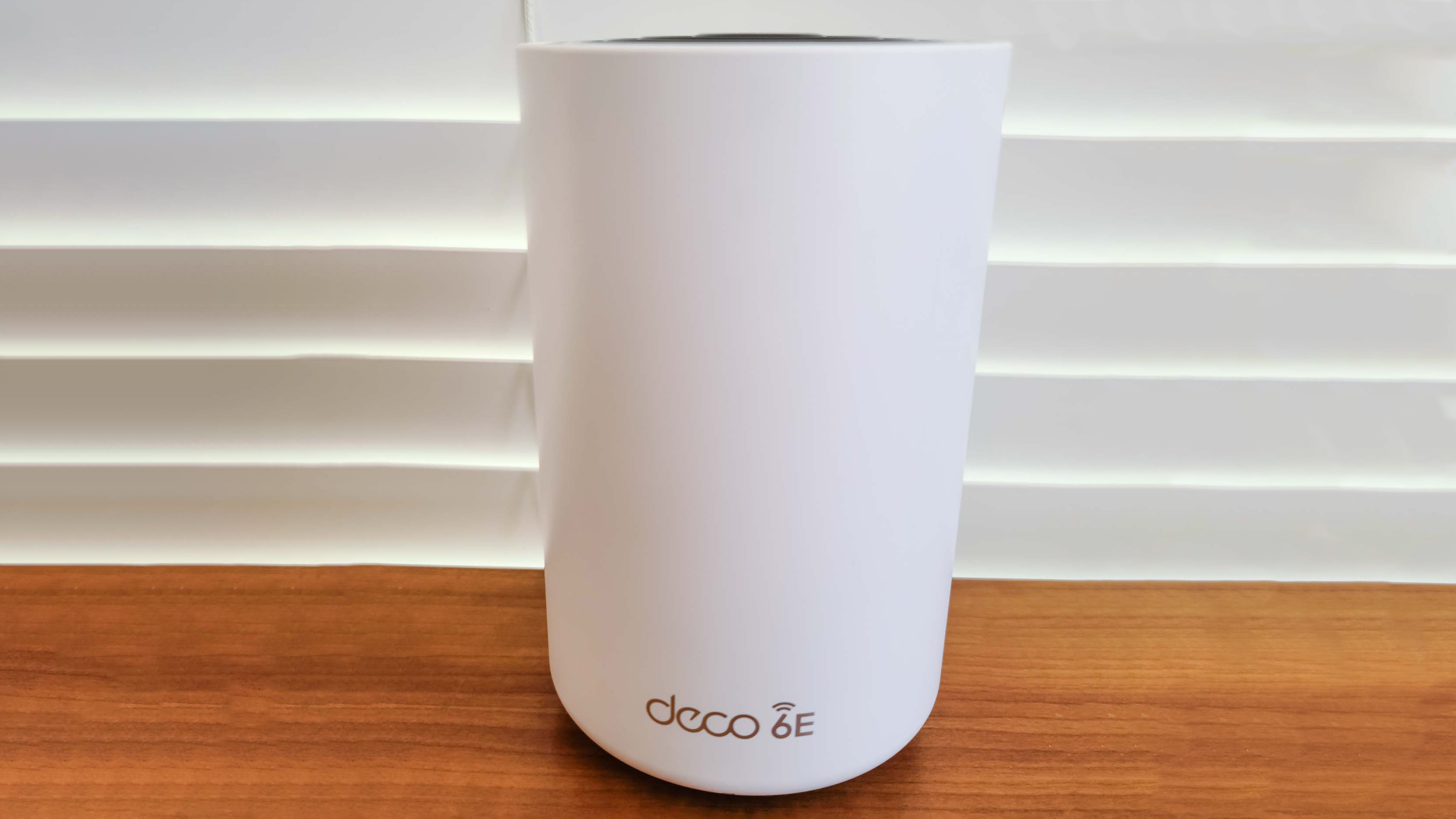
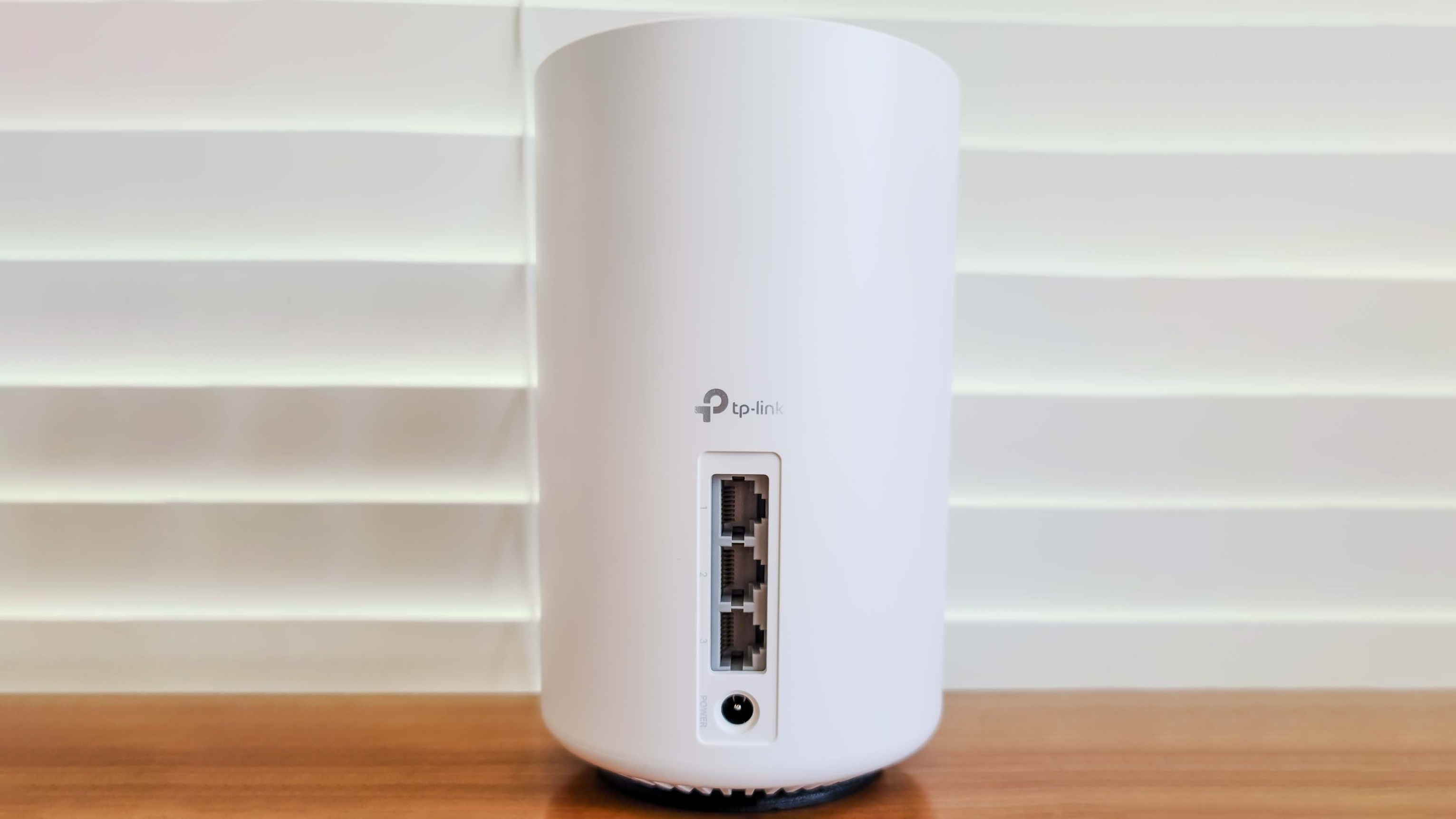

Specifications
Reasons to buy
Reasons to avoid
✅ You want Wi-Fi 6E on a budget: This is one of the best Wi-Fi 6E mesh systems you can get in a three-pack for under $500.
✅ You want built-in security software: TP-Link includes its HomeShield security software free of charge.
❌ You have multi-gig internet: This mesh router only has gigabit ports unlike the Deco XE75 Pro.
❌ You want a lot of ports: There are only three Ethernet ports and no USB ports.
If you want significantly faster download and upload speeds but aren’t quite ready to make the jump to Wi-Fi 7, the Wi-Fi 6E-powered TP-Link Deco XE75 is an excellent choice for building out a mesh network. Available in either a two-pack or a three-pack, these cylindrical mesh routers are fairly compact and dont’ stand out too much either. You also get a bit of flexibility when it comes to how you set them up since any of the units can act as your main router. When I wanted to upgrade to mesh without spending a fortune, this is the mesh Wi-Fi system I picked.
The TP-Link Deco XE75 is ideal for gigabit internet plans and around back, there are three gigabit Ethernet ports. If you have a multi-gig plan and want faster wired ports, there’s also the slightly more expensive Deco XE 75 Pro. In our testing, we were able to get over 1.2 Gbps download speeds at 15 feet and this mesh Wi-Fi system was also able to send a strong connection through walls. While this isn’t a quad-band device, you do have the option to use its 6 GHz band for wireless backhaul which is great if you don’t have a lot of newer devices with Wi-Fi 6E support.
Like other TP-Link routers, the Deco XE75 comes with the company’s HomeShield security software built-in. You can also upgrade to HomeShield Pro for additional protection from the latest online threats.
The TP-Link Deco XE75 is a strong and reliable mesh Wi-Fi kit that I’ve used for several years now without any problems or issues. If you want Wi-Fi 6E speeds and features without the extra cost of some other mesh routers, this is a great option for your home network.
Read our full TP-Link Deco XE75 review
The best mesh Wi Fi system for gamers



Specifications
Reasons to buy
Reasons to avoid
✅ You want a gaming router: The Asus ROG Rapture 6 looks like a gaming router but offers the range of a mesh Wi-Fi system.
✅ You want a router that stands out: The Asus ROG Rapture 6 includes built-in RGG and looks more like a compact gaming PC than a router.
❌ You want the latest Wi-Fi tech: The Asus ROG Rapture GT6 still uses Wi-Fi 6 instead of Wi-Fi 6E or even Wi-Fi 7.
Having to choose between one of the best gaming routers and a mesh Wi-Fi system used to be tough for those who wanted the best online gaming experience but still had Wi-Fi dead spots around their home. The Asus ROG Rapture GT6 gives you the best of both worlds with a design where it won’t look out of place next to one of the best gaming PCs.
As part of Asus’ Republic of Gamers (ROG) line, the Rapture GT6 naturally comes equipped with built-in RGB lighting and comes in either black or white to match the rest of your desk setup. This mesh router has a very futuristic look overall and you will probably want to leave it on your desk instead of hidden away. The Asus ROG Rapture GT6 also has a trapezoidal shape which is quite uncommon for a mesh Wi-Fi system.
You aren’t getting the latest Wi-Fi tech here but Asus has pulled off a few tricks to get the most out of Wi-Fi 6. The ROG Rapture GT6 uses 160 MHz data channels along with beamforming to push Wi-Fi 6 to the max. Right next to the first mesh router built for gamers, we hit a max speed of 1.36 Gbps for second in our tests. Speeds dropped off a bit at 50 and 75 feet but they were still quite impressive.
It’s worth noting that the ROG Rapture GT6 is only available in a two-pack but even then, this mesh Wi-Fi system can cover 5,800 square feet with a strong Wi-Fi signal. You do get a 2.5 Gbps input port, three gigabit Ethernet ports and a USB port on the back of both units though. Through the app or your browser, you can customize the ROG Rapture GT6’s RGB lighting and dive into the Game Radar worldwide ping map and the rest of Asus’ gaming features. If you want the best gaming performance while eliminating Wi-Fi dead zones with one of the most unique designs in a mesh router we’ve seen yet, the ROG Rapture GT6 doesn’t disappoint.
Read our full Asus ROG Rapture GT6 review
The best mesh Wi Fi system for long range



Specifications
Reasons to buy
Reasons to avoid
✅ You have a multi-gig internet plan: With a 10 Gbps input port and four 2.5 Gbps downstream ports, this is mesh system is very well suited for multi-gig internet.
✅ You need extra range: With a max range of 115 feet and great mid-range as well as long-range speeds, the Orbi 870 is a great choice for larger homes or properties.
❌ You're on a budget: At $1,000 for a two-pack and $1,300 for a three-pack this is a high-end Wi-Fi 7 mesh Wi-Fi system.
❌ You need a USB port: Unlike the Deco BE85, the Orbi 870 doesn’t have a USB port around back for sharing data from a flash drive or hard drive across your home network.
The Orbi 870 from Netgear is a Wi-Fi 7 powered mesh system that excels at both medium and long range performance. Positioned between the more expensive Orbi 970 and the cheaper Orbi 770, this mesh router gives you all of Wi-Fi 7’s best features in a slightly more compact form factor compared to its more expensive sibling. Still, at $1,000 for a two-pack and $1,300 for a three-pack, you are paying the Orbi tax compared to cheaper yet similarly specced offerings from TP-Link like the Deco BE63, though the Orbi 870 can reach a max theoretical throughput of 21 Gbps (versus 10 Gbps).
Just like the rest of Netgear’s Wi-Fi mesh routers, the Orbi 870 is quite tall at 10.6 inches and it has plenty of Ethernet ports but no USB port around back. Perfectly equipped for multi-gig internet, you get a 10 Gbps input port along with four 2.5 Gbps downstream ports. In our network benchmark testing, it reached speeds of 1.82 Gbps at a distance of 15 feet which puts it slightly above both the Orbi 770 and the Deco BE85. What really surprised us though was just how capable this mesh kit was at medium and long-range distances. For instance, at both 50 and 75 feet, we saw speeds of 627.4 Mbps and 628.6 Mbps respectively. Then at 90 feet away from the router, we were still able to reach 102.6 Mbps. This makes the Orbi 870 a great choice if you still want to be able to stream content or even do video calls out in your backyard.
Netgear didn’t skimp on Wi-Fi 7 features with the Orbi 870 either. Along with access to the faster 6 GHz band, you also get Multi-Link Operation support for using multiple bands at once, ultra-wide 320 MHz data channels for moving more data across your network. Setup can be done either in Netgear’s Orbi app or through your browser and from start to finish, it took us 17 minutes to get our home network up and running.
The Orbi 870 is a powerful and reliable mesh Wi-Fi system you’ll be able to use for years thanks to its multi-gig ports and excellent close, mid-range and long distance performance. You will have to pay extra for security software for your home network but with your Armor subscription, you now get VPN access too, along with antivirus protection from bitdefender. The Orbi 870 may be in the middle of Netgear’s Wi-Fi 7 mesh range but it packs in as many features and the performance you’d find on competitors’ flagship mesh systems.
Read our full Netgear Orbi 870 review.
The best mesh Wi Fi system for large homes



Specifications
Reasons to buy
Reasons to avoid
✅ You want built-in security: Asus includes its powerful AiProtection Pro security software for free with this mesh router.
✅ You want something compact: At almost 10 inches tall, hiding Asus' ZenWiFi Pro ET12 units will likely be quite difficult.
❌ You have a very big home: Since the Asus ZenWiFi Pro ET12 doesn't come in a three-pack, it will be difficult to have a strong Wi-Fi signal throughout larger houses.
❌ You want the fastest data channels: This mesh router doesn't support 320 MHz data channels which allow for much faster speeds.
If you don’t mind sticking with Wi-Fi 6E and want a mesh Wi-Fi system with a beautiful design, the Asus ZenWiFi Pro ET12 could be just what you’re after. Like the ROG Rapture GT6, it’s also only available in a two-pack (but you can buy additional single units) and just comes in black.
Our pictures barely do its unique design justice and the Asus ZenWiFi Pro ET12 almost looks like a desktop model of a skyscraper with its chrome accents and clear top which makes it perfect for displaying on your desk or on top of a bookshelf. Another neat thing is that when viewed from above, you can see several of its 10 antennas. This clear section at the top also lights up and at night, the ZenWiFi Pro ET12 just exudes elegance.
As for performance, we saw download speeds of 1.27 Gbps at a close distance and very strong speeds of 586 Mbps at 50 feet. The ZenWiFi Pro ET12 also has a max range of 105 feet which makes it an ideal choice for larger homes even if you can only buy two units in a bundle. Asus gives you a good selection of ports with the ZenWi-Fi Pro ET12 too and you get a 2.5 Gbps input port, along with another 2.5 Gbps Ethernet port and two gigabit ones.
While you might tuck a normal router out of sight, mesh routers by their very nature need to be spread throughout your home. If you want a fast and capable mesh Wi-Fi system that’s one of the best looking devices we’ve reviewed yet, the ZenWiFi Pro ET12 could be just what you’re looking for.
Read our full Asus ZenWiFi Pro ET12 review
Best mesh Wi Fi system for Wi Fi 7



Specifications
Reasons to buy
Reasons to avoid
✅ You want Wi-Fi 7: If you need the latest and greatest wireless tech for slightly cheaper than the competition, this is the mesh Wi-Fi router to get.
✅ You don't want to have to upgrade later: This mesh Wi-Fi system won't need to be upgraded for years as it ships with Wi-Fi 7 and can cover 9,600 square feet.
❌ Your internet plan isn't multi-gig: Without a multi-gig internet plan, you won't be able to truly take advantage of Wi-Fi 7's faster speeds.
❌ You're on a budget: At $1,500, the Deco BE85 is cheaper than other mesh routers with Wi-Fi 7 but not by much.
If the Netgear Orbi RBE973 is out of your budget and there’s a good chance it is but you still want a powerful as well as futureproof mesh Wi-Fi system, then the TP-Link Deco BE85 is a fantastic option. In addition to being the first Wi-Fi 7-powered mesh kit, it undercuts the Orbi RBE973 by $800 with better mid-range performance and overall range.
You’re still paying a premium compared to TP-Link’s more affordable Wi-Fi 6E mesh routers like the Deco XE75 but since our review, the company has released its much cheaper Deco BE63. For the price though, you’re getting all of Wi-Fi 7’s best features like ultra-wide 320 MHz data channels, 4K QAM and Multi-Link Operation with the Deco BE85. This mesh Wi-Fi system also sports a very clean design with a seven etched on its front to remind you that you’re using the latest Wi-Fi tech.
When testing the Deco BE85, we reached download speeds of 1.73 Gbps at 15 feet which isn’t too far off the Orbi RBE973’s 2 Gbps. At 50 feet, download speeds also held strong at 790 Mbps. If you have a home filled with connected devices, you’re in luck as each Deco BE85 unit can support up to 200 of them at a time. Also, like with the Deco XE75, you can choose to use this mesh router’s 6 GHz band for wireless backhaul if your home isn’t wired for Ethernet.
TP-Link managed to pack a ton of ports into the back of the Deco BE85 including two 10 Gbps input ports, two 2.5 Gbps Ethernet ports and a USB port. For those with fiber internet, one of the 10 Gbps ports can be paired with an SFP+ port too. If you want to make the most out of your multi-gig internet plan and don’t plan on upgrading your mesh network for the next few years, the Deco BE85 is a worthwhile investment.
Read our full TP-Link Deco BE85 review
The best budget mesh Wi Fi system for Wi Fi 7
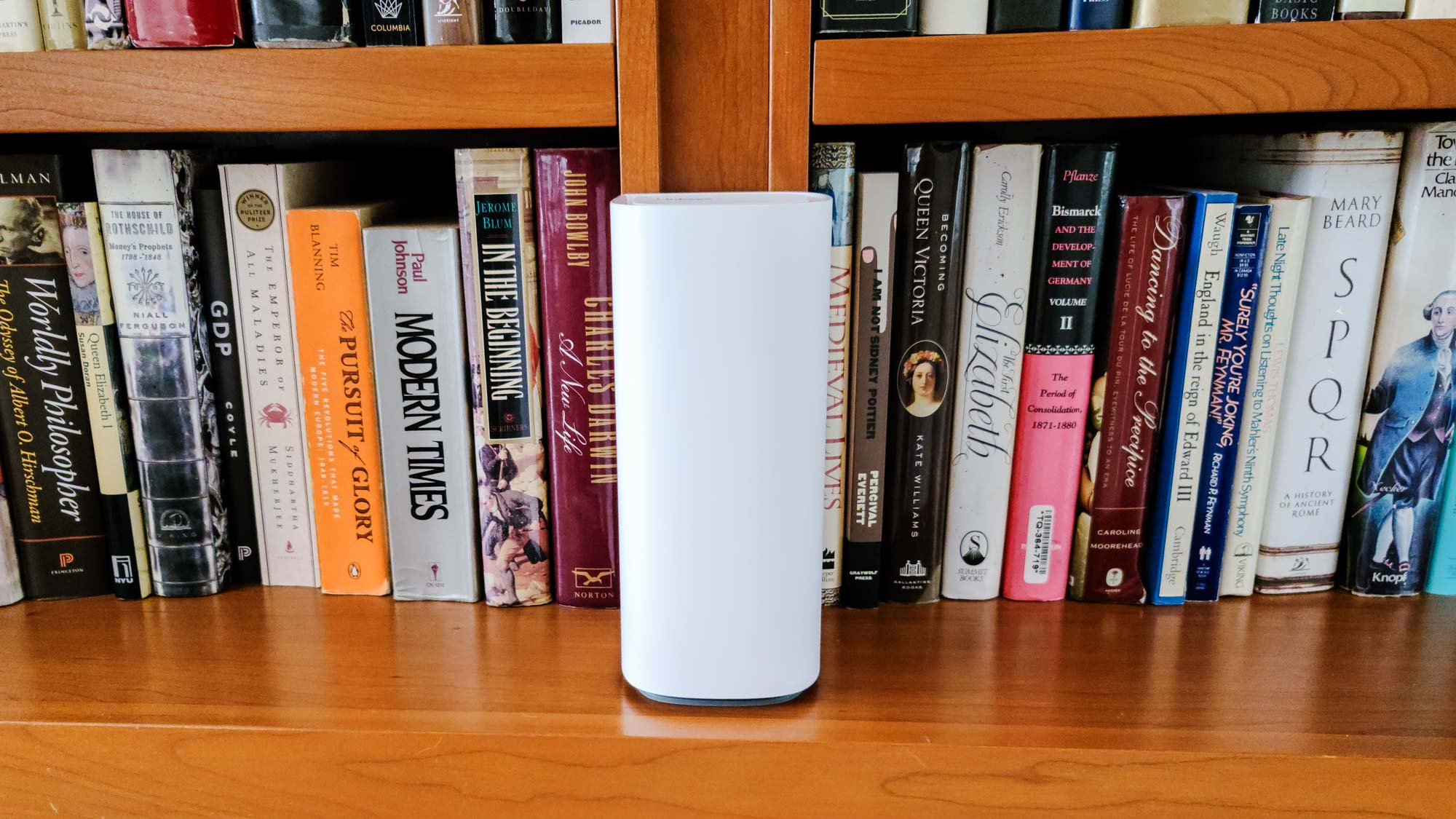


Specifications
Reasons to buy
Reasons to avoid
✅ You want Wi-Fi 7 on a budget: The Velop Pro 7 is one of the first mid-range Wi-Fi 7 mesh kits which makes it more affordable than both the Orbi RBE973 and the Deco BE85.
✅ Your house isn't wired for Ethernet: This mesh kit can tap into faster 240 MHz channels for backhaul communications between the units.
❌ Your want the fastest Wi-Fi 7 performance: The Velop Pro 7 didn't set any speed records in our tests like the other Wi-Fi 7 mesh kits on this list did.
❌ You have multi-gig wired devices: With only gigabit downstream ports, you won't be able to get top speeds on your wired devices with multi-gig ports.
Alternatively, what if you want to take advantage of Wi-Fi 7’s faster speeds but don’t want to spend nearly as much as you would on the Orbi RBE973 or the Deco BE85? Well, that’s where the Linksys Velop Pro 7 comes in. You can pick up a three-pack for less than $1,000 and don’t need to spend more on a multi-gig internet plan to take full advantage of this mesh router.
Linksys trimmed the fat if you will with the Velop Pro 7 and it’s a much more compact device than the Atlas Max 6E. It also has a more modern look with rounded edges, no branding on the side and only a single LED status light at the top.
While the Velop Pro 7 packs in all of Wi-Fi 7’s main features like its more expensive counterparts, some compromises did need to be made to lower its price. For instance, you only get a 2.5 Gbps input port with four gigabit Ethernet ports for your wired devices. The Velop Pro 7 also never managed to reach over a gigabit per second in download speeds in our tests. Up close to the router at 15 feet, we reached a top speed of 916.7 Mbps, though speeds held up fairly well at 50 feet with a total range of 95 feet.
You are losing out a bit in terms of speeds and when it comes to port selection but you are getting all of the other benefits of Wi-Fi 7. Linksys also throws in free security software which uses machine learning to filter dangerous sites to soften the blow. We’re now seeing even more mid-range Wi-Fi 7 routers and mesh Wi-Fi systems, so keep your eye out for our latest reviews. Still though, the Velop Pro 7 is a big upgrade over Linksys’ previous mesh offerings and it will let you experience everything Wi-Fi 7 has to offer without nearly as much sticker shock.
Read our full Linksys Velop Pro 7 review
The best mesh Wi Fi system for dual band Wi Fi 7
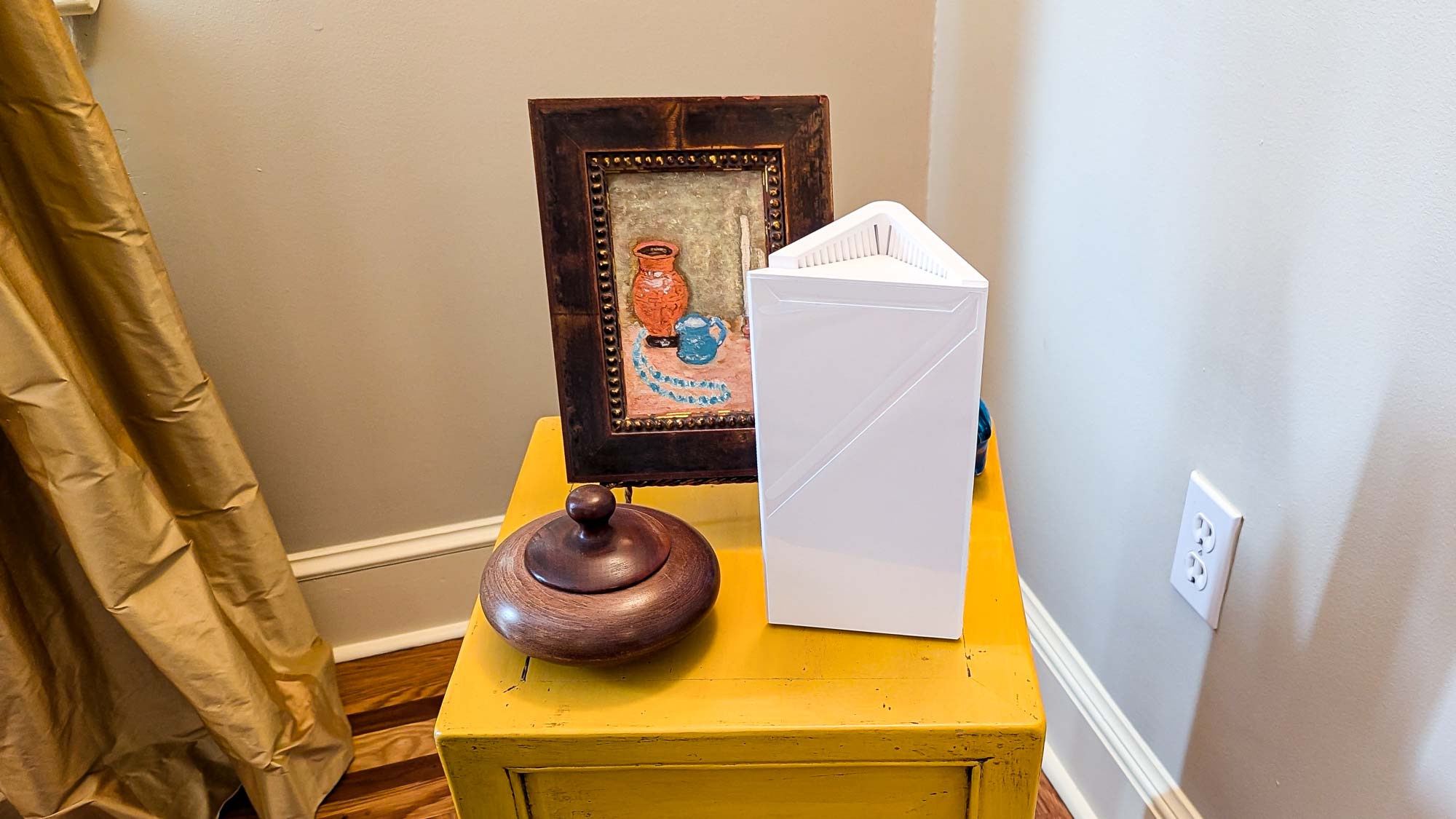


Specifications
Reasons to buy
Reasons to avoid
✅ You want Wi-Fi 7 features on a budget: The Roamii BE Lite gives you access to Wi-Fi 7’s best new features like MLO which lets you use multiple bands simultaneously without breaking the bank.
✅ You only have gigabit internet: Even with a 2.5 Gbps input port, we saw max download speeds of 970.3 Mbps during testing which makes this dual-band mesh kit perfect for gigabit internet.
❌ You want the fastest speeds possible: Since this is a dual-band Wi-Fi 7 mesh kit and not a tri-band one, you don’t get access to the faster 6 GHz band.
❌ You have a larger home: The Roamii BE Lite is currently only available in a two-pack and covers 5,800 square feet, so if you have a large home, you might want to look for a mesh system that comes in a three-pack instead.
If the sticker shock of the first Wi-Fi 7-powered mesh systems was too much for your budget but you want almost all of the latest wireless standard, then the MSI Roamii BE Lite just might be for you. Unlike other Wi-Fi 7 and even Wi-Fi 6E mesh kits, this one is dual-band instead of tri-band. This means that while you get access to the 2.4 and 5 GHz bands, you won’t be able to use the faster 6 GHz ones. Great if you don’t have any Wi-Fi 6E or Wi-Fi 7 devices in your home but still want the latest wireless tech in your router.
The MSI Roamii BE Lite is actually the first dual-band Wi-Fi 7 device we’ve reviewed but expect an onslaught of them to release this year. This is also MSI’s first mesh Wi-Fi system and the start of its new Roamii line with the Roamii BE Max and the Roamii BE Pro (both tri-band systems) scheduled to release later this year. Although you won’t be able to use the faster 6 GHz band with this system, you do get access to most of the new standard’s best features like Multi-Link Operation (MLO), 4K QAM and MU MIMO. For what the Roamii BE Lite lacks in sheer speed, it makes up for in affordability with a two-pack costing just $300.
The Roamii BE Lite can cover up to 5,800 square feet with a strong Wi-Fi signal while supporting more than 120 connected devices simultaneously. During our testing, it reached a top speed of 970.3 Mbps with our test laptop 15 feet away from the router. The Roamii BE Lite had a maximum range of 105 feet and even at a distance of 90 feet, we saw download speeds of 46.7 Mbps. It might be worth getting a more expensive, tri-band mesh Wi-Fi system if you have multi-gig internet at home but if you have gigabit internet or lower, the Roamii BE Lite will allow you to take full advantage of your internet plan.
Unlike the latest mesh Wi-Fi systems from TP-Link and Netgear which have a cylindrical design, the Roamii BE Lite sports a triangular design with a glossy seven on the front to let you know that this is in fact a Wi-Fi 7 mesh kit. On the backside, there’s a 2.5 Gbps input port for multi-gig internet along with two gigabit ports for your wired devices. There isn’t a USB port for sharing data across your network and you might need to purchase a network switch separately if you have a lot of wired devices. In terms of extras, you get built-in security software and parental controls along with wall mounting brackets in the box. The Roamii BE Lite is an impressive first attempt at a Wi-Fi 7 mesh router but if you want the faster speeds that come with the 6 GHz band, it might be worth waiting for the Roamii BE Max or Pro later this year.
Read our full MSI Roamii BE Lite review.
The best mesh Wi Fi system for Wi Fi 6E
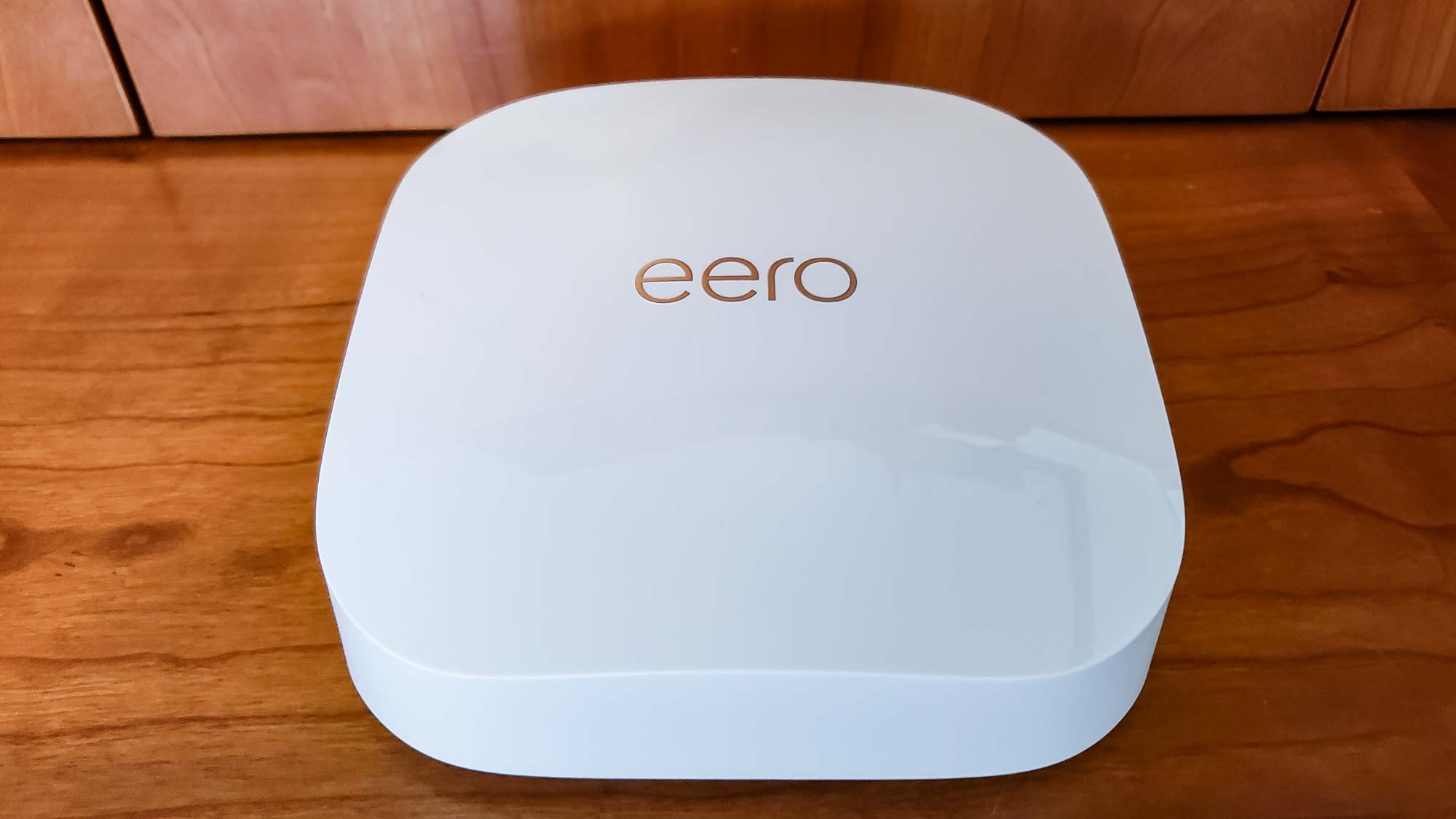


Specifications
Reasons to buy
Reasons to avoid
✅ You want a compact mesh router: The eero Pro 6E is quite small and easy to hide on a bookshelf or desk.
✅ You don't have a smart home hub yet: With Zigbee and Bluetooth built-in, you can use the eero Pro 6E as the center of your smart home.
❌ You need a lot of ports: The eero Pro 6E only has two Ethernet ports in total (one gigabit Ethernet port and one 2.5 gigabit Ethernet port).
❌ You're concerned about range: Each eero Pro 6E unit has a range of 85 feet whereas some other mesh routers can reach as far as 100 feet.
The Eero Pro 6E and Amazon’s other Eero mesh routers take the guesswork out of setting up and managing a mesh network. From start to finish, it took us 10 minutes to set up the three-piece mesh kit we reviewed. If you’re looking for an easy to use mesh Wi-Fi system with Wi-Fi 6E, the Eero Pro 6E is the perfect choice. However, if you want Wi-Fi 7 and have the budget, check out the Eero Max 7. Alternatively, you can pick up theWi-Fi 6-powered Eero 6+ for a lot less than the Eero Pro 6E and it has a much more compact design.
The Eero Pro 6E is the perfect middle ground between the Eero Max 7 and the Eero 6+. Design wise, it’s still on the small side but looks more like a Mac Mini and we had no trouble lying it flat on a desk or even on a bookshelf. It was quite fast in our testing too and at a close distance, we saw download speeds of 1.44 Gbps. The Eero Pro 6E is also a good choice for people with multi-gig internet or for those thinking about upgrading in the future thanks to the inclusion of a 2.5 Gbps Ethernet port along with a gigabit one beside it.
Like the Google Nest Wifi Pro, the Eero Pro 6E can do more than fill a home with a strong Wi-Fi signal with each unit covering up to 2,000 square feet. It also has a built-in Zigbee radio and Matter support which lets you use this mesh Wi-Fi system to control the best smart home devices too. Speaking of smart homes, you can even use an Echo Dot as a mesh extender if there are parts of your house or even your backyard without Wi-Fi.
The Eero Pro 6E has one more trick up its sleeve but for that you need to sign up for Amazon’s Eero Plus subscription ($10 per month or $100 annually). I know the last thing you need is another subscription service but Eero Plus can be quite useful when your internet goes down as you can set up Eero Internet Backup to have your phone’s mobile hotspot keep your home network up and running. The Eero Pro 6E packs in quite a lot of features but it’s the simple and quick setup process — along with the Eero app — that really helps this mesh Wi-Fi router stand out among other Wi-Fi 6E devices.
Read our full Eero Pro 6E review
Router specs
Wi-Fi Router | Wi-Fi Generation | Wi-Fi Spec | Ports | Dimensions (LWH) |
|---|---|---|---|---|
Netgear Orbi RBE973 | Wi-Fi 7 | BE27000 | 1 x 10 Gbps WAN, 1 x 10 Gbps and 4 x 2.4 Gbps LAN (router), 1 x 10 Gbps and 2 x 2.5 Gbps LAN (satellites) | 11.4 x 5.5 x 5.1 inches |
TP-Link Deco XE75 | Wi-Fi 6E | AXE5400 | 3 x gigabit WAN/LAN | 6.8 x 4.1x 4.1 inches |
Asus ROG Rapture GT6 | Wi-Fi 6 | AX10000 | 1 x 2.5 Gbps WAN, 3 x gigabit LAN, 1 x USB 3.2 | 7.1 x 6.2 x 3.0 inches |
TP-Link Deco BE85 | Wi-Fi 7 | BE22000 | 2 x 10 Gbps WAN, 1 xSPF+ fiber port, 2 x2.5 Gbps LAN | 9.2 x 5.0 x 5.0 inches |
Linksys Velop Pro 7 | Wi-Fi 7 | BE11000 | 1 x 2.5 Gbps WAN, 4 x gigabit LAN | 8.7 x 3.7 x 3.7 inches |
Eero Pro 6E | Wi-Fi 6E | AX5400 | 2 x gigabit WAN/LAN | 5.5 x 5.5 x 2.1 inches |
MSI Roamii BE Lite | Wi-Fi 7 (dual-band) | BE5000 | 1 x 2.5 Gbps WAN, 2 x gigabit LAN | 9.6 x 4.8 x 4.8 inches |
Netgear Orbi RBK863SB | Wi-Fi 6 | AX6000 | 1 x 10 Gbps WAN, 4 x gigabit LAN (router), 4 x gigabit LAN (satellites) | 10.0 x 7.5 x 2.8 inches |
Asus ZenWiFi Pro ET12 | Wi-Fi 6E | AXE11000 | 1 x 2.5 Gbps WAN, 1 x 2.5 Gbps LAN and 2 x gigabit LAN | 4.6 x 4.6 x 9.8 inches |
Linksys Atlas Max 6E | Wi-Fi 6E | AXE8400 | 1 x 5 Gbps WAN, 4 x gigabit LAN, 1 USB 3.0 (router/satellites) | 9.6 x 4.5 x 4.5 inches |
Testing results
How we test the best mesh Wi-Fi systems

We test every mesh Wi-Fi system to measure performance and range, using Keysight IxChariot. Testing is done in a multi-story home with brick walls. As with standard routers, we test performance at a distance to provide real-world information about coverage and speeds. In addition to lab testing, we evaluate the ease-of-setup and features of each device too.
We measure performance at a 15-foot distance without obstructions, so that we can gauge the maximum amount of data that a router can move. Higher throughput will serve you better in data-heavy uses, like streaming video, gaming, or connecting multiple users at once.
Range measures the furthest usable distance for a particular router. Longer ranges are better for larger homes, where rooms are spread out at a distance. We measure how much data a router can move at 15, 50, 75 and 100 feet, as well as the maximum coverage area of a mesh Wi-Fi system.
We also test how well each mesh Wi-Fi system transmits and receives signals through drywall, brick, concrete and even metal walls; and how each handles coverage in a two- or three-story home. They also go thorugh additional testing to see how well each system does when sending a signal through the main router and through the included satellites.
For more information, check out our guide on how we test Wi-Fi routers as well as our more general how we test page for Tom's Guide.
Meet our testers

As someone who's been working from home for the past six years, Anthony Spadafora has tried everything from Wi-Fi extenders to powerline adapters to get the most out of his home network before finally upgrading to a mesh Wi-Fi system. Along the way, he's tested out loads of different routers and network configurations. Based on what he's learned, Anthony tries to highlight the critical role Wi-Fi routers play in our day to day lives and how a mesh network can help solve the most common connectivity issues like Wi-Fi dead spots.

With experience in testing, using and evaluating wireless data from before Wi-Fi was even a word, Brian Nadel has tried out and reviewed every major router available in his home networking lab. A LAN nerd, his philosophy is to use the router the way you would, testing networking gear for ease of setup, performance, security and above all for value. The result is peace of mind when it comes to choosing the right router.
Mesh router vs Wi-Fi router

A regular Wi-Fi router creates a single access point that broadcasts Wi-Fi signals to limited area whereas mesh networks link two or more access points (which are also called satellites) together with your router.
The main issue with traditional routers is that the reach of the Wi-Fi signals they send out is limited. Large buildings that require internet access on multiple floors often have areas with little or no service, often referred to as dead zones, when the main network uses a standard single-point router.
With a mesh Wi-Fi router though, one access point acts as the router or base station and connects to one of the best cable modems to get internet access. Meanwhile, the other nodes act as satellites, receiving internet from the base station and then rebroadcasting it to nearby devices.
All of these units share data back and forth and provide multiple sources of Wi-Fi. One of the best things about a mesh system is that unlike with Wi-Fi extenders, they all share the same network, so you won’t have to switch to a new network as you move throughout your house.
For those who aren’t sure if they need a mesh Wi-Fi system, or plan on moving into a larger home soon, you don't have to commit to a pack of two or three mesh units to benefit from the expandable coverage of mesh Wi-Fi.
Many of the latest standalone routers can actually be set up as base stations for mesh coverage and then you can expand your Wi-Fi further by adding more nodes from the same manufacturer down the line. This way you don’t have to get rid of your current equipment.
Whichever way you go in the end though, you should analyze your Wi-Fi needs and your internet speeds first to determine which solution is best for your home. The best speed test apps can also be really useful when determining whether or not you need a mesh Wi-Fi system.
How long do mesh Wi-Fi systems last?

Just like with a traditional router, a mesh router should last for at least five years or possibly even longer. Normally, it’s not the hardware itself that fails. Instead, you’re going to want to replace your mesh Wi-Fi system once it stops receiving manufacturer updates. Besides new features, these updates also contain security patches.
Given that everything your entire household does online flows through your router, you want to keep all of the devices that make up your mesh network updated and running the latest firmware and patches.
It’s worth noting that once a device stops receiving updates, there will likely already be a new wireless standard with extra features, faster speeds, etc. and this can be a good incentive to upgrade as well.
Although eero continues to support every mesh Wi-Fi system it has ever released with new updates, other hardware makers set clear end-of-life dates for their products. You can find out when your mesh router will no longer be supported by checking the lists for Asus, Netgear and TP-Link.

If you’re worried about hardware failure though, you want to make sure that your mesh router has plenty of airflow and that it’s not located in a place that’s too cold, too hot or has a lot of moisture. Since power outages can kill a mesh router instantly, you want to make sure that all of the devices in your mesh network are plugged into one of the best surge protectors to avoid having to replace them sooner than you normally would.
Should I get a two-piece or three-piece mesh Wi-Fi system?
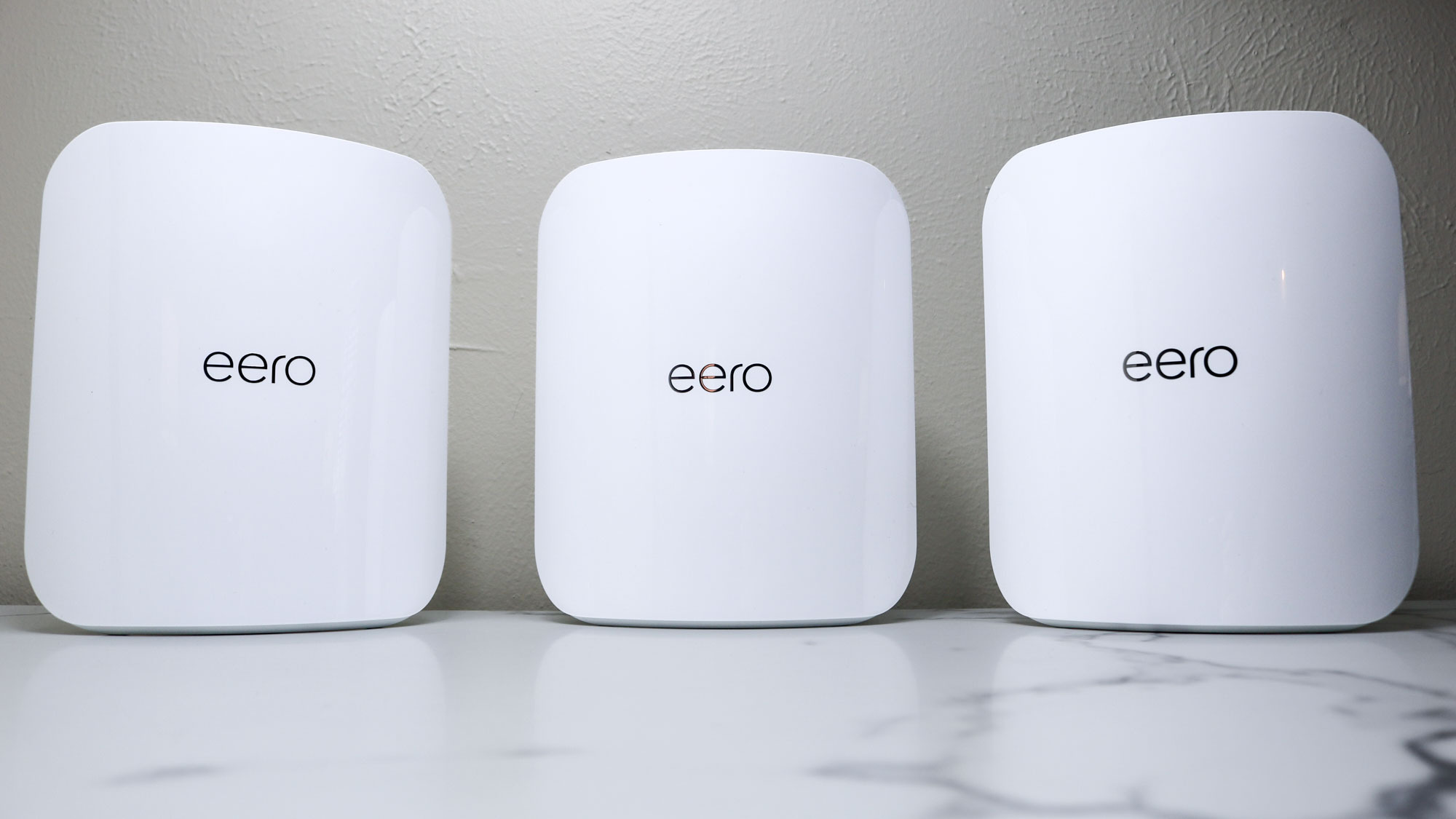
Before you even start shopping for a mesh Wi-Fi system, you want to familiarize yourself with your home’s layout and how much square footage you need to cover with a strong Wi-Fi signal. Networking companies typically highlight the coverage range for each mesh unit individually or if you’re shopping for a two-piece or three-piece mesh kit, they might double or triple it to reflect the square coverage for that particular product listing.
Based on our testing, we’ve found that a two-piece mesh Wi-Fi system will cover most homes with a strong Wi-Fi signal but if your house is on the larger side, you might still have some Wi-Fi dead zones in some areas. In that case, you’re going to want to go with a three-piece mesh Wi-Fi system instead.
If you bought a two-pack, set it up and are still experiencing dead zones, you have two options: you can return it (if possible) or you can add a third unit for better coverage. Most networking companies sell their mesh routers individually, so this shouldn’t be a problem. However, you will usually spend more if you take this approach which is why you want to get the right number of mesh devices for your network from the start.
Do I have to buy everything at the same time?

The good news about the best mesh Wi-Fi systems is that no, you don’t have to get everything at once. Let’s say you know you need a three-piece mesh kit to cover your whole house with Wi-Fi but you only have enough in your budget for a two-piece kit or even a single unit. In that case, you can get one or two devices now and then add others to your mesh network later on.
This approach can work really well if your previous router died out of nowhere and you just need a replacement really quickly. Then, you can wait for a sale to add more mesh units to your network.
Keep in mind though that buying a three-pack will definitely be cheaper than buying a two-pack and a single unit later on, unless you do so when that extra unit is on sale.
What’s the best place to put your mesh router?
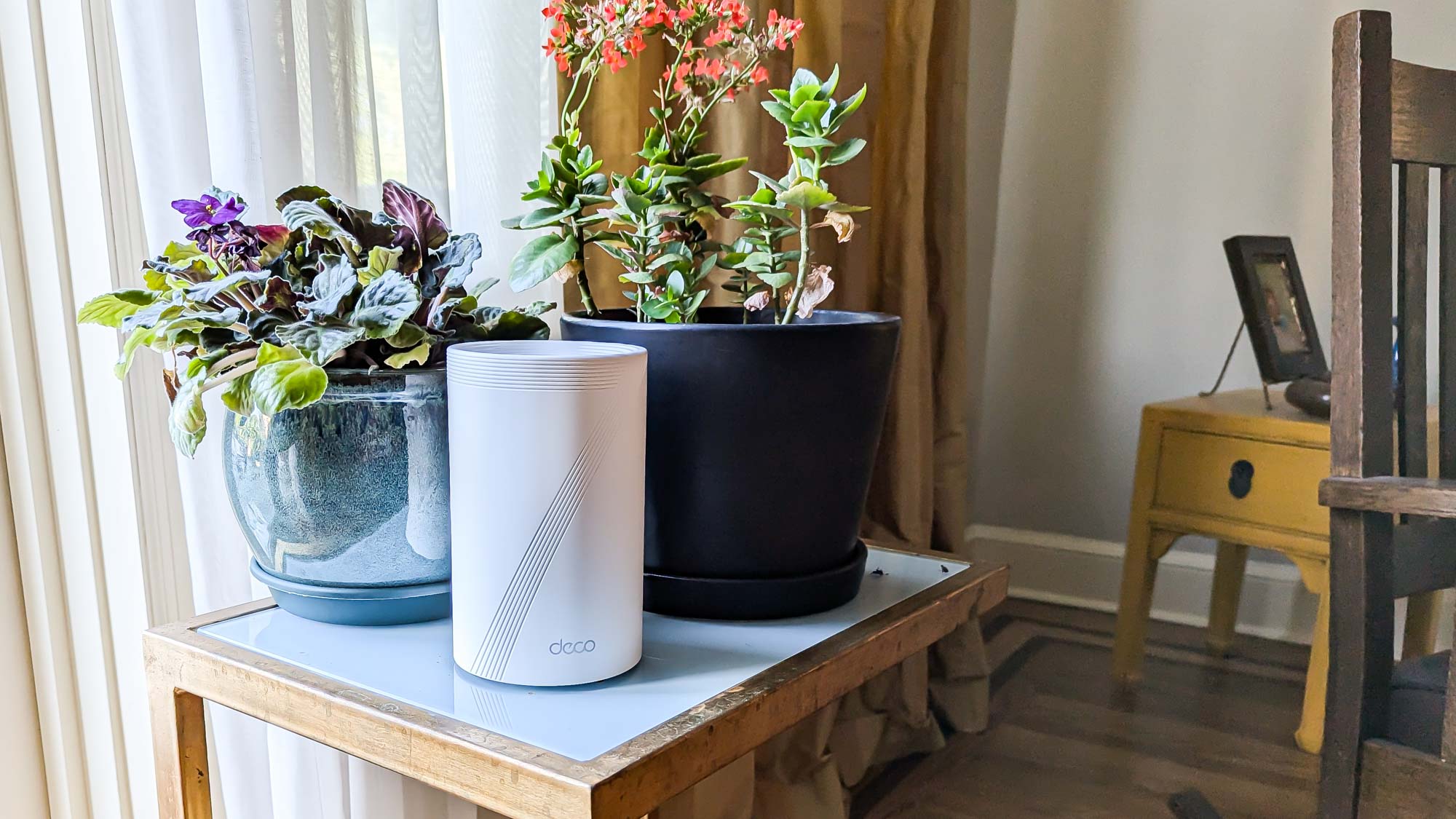
Unlike with a traditional Wi-Fi router, you have quite a bit more flexibility with a mesh Wi-Fi system when it comes to placement since you have at least two or maybe even three devices.
While some mesh routers and their satellites are identical and can be used interchangeably, other mesh kits designate one device as the router and the others as satellites. For instance, Netgear does this with many of its Orbi devices while TP-Link’s Deco and eero’s mesh routers can be used as either your main router or a satellite.
With the unit that serves as your main router, it will need to be close to your cable modem or where your fiber internet connection comes into your house. Still though, you want to follow the same placement rules that you would with a traditional router. These include having your router up as high as possible and keeping it away from large metal objects and big appliances like your refrigerator or stove to limit interference.
Once your main router is set up, it’s time to start placing satellites around your home. These too should be elevated instead of on the ground for a better signal and they also need to be far away from large appliances to avoid interference. To make things easier, mesh router apps will often include a walkthrough on where to put the satellites and many of them will also let you test the strength of your network once you have all of them in place.
If your mesh router doesn’t come with an app or the app doesn’t offer this functionality, don’t worry as a bit of planning can help you place your satellites correctly on your own. The way that I like to do this is by thinking about my main router and its satellites like the points of a triangle. If your mesh unit acting as your router is in the center of your house, then you’re going to want to put one satellite on the left side and the other on the right side of your home. Keep in mind though, you don’t want them too far apart as they won’t be able to relay a signal back to one another.
Wireless vs wired backhaul

One of the main things that sets mesh Wi-Fi systems apart from traditional routers is that your main mesh router needs to be able to communicate with its satellites in order to create a mesh network in the first place. If it can’t, a mesh router will work in the exact same way as a regular router which defeats its purpose.
This communication between a mesh router and its satellites is called backhaul and there are two ways to do it. If your house is wired for Ethernet and the main unit acting as your router and all the satellites are plugged into the wall, you’re going to see better performance and speeds. If your home isn’t wired for Ethernet, don’t worry as mesh routers can also use wireless backhaul to communicate with one another.
By using the 5 Ghz band or the 6 Ghz band, your main unit and its satellites send data back and forth to one another. This does take up a decent amount of traffic on the band that’s being used which is why some mesh routers like the TP-Link Deco XE75 let you designate a specific band for wireless backhaul. For instance, let’s say you don’t have any Wi-Fi 6E or Wi-Fi 7 devices that utilize the 6 Ghz band. In that case, you can use it for wireless backhaul and the rest of your connected devices won’t be impacted at all.
At the same time, some mesh routers like the Orbi RBE973 from Netgear are quad-band instead of tri-band. While a tri-band Wi-Fi 6E or Wi-Fi 7 mesh router gives you access to the 2.4, 5 and 6 Ghz bands, a quad-band mesh router adds either an extra 5 Ghz or 6 Ghz band that is specifically designed for wireless backhaul. This is something you want to keep in mind when shopping for your first mesh router or when upgrading your existing mesh router.
Overall, wired backhaul is ideal, wireless backhaul on a dedicated band is great and wireless backhaul on a band used by your other devices is still good. The right one for your home network will depend on whether or not your house is wired for Ethernet along with the capabilities of your mesh Wi-Fi system.
How to choose the best mesh Wi-Fi system for you

Coverage: If you have a larger home with 3,000 square feet or more, a regular router just won’t cut it. The same is true for multistory homes and oddly laid out houses, which don’t necessarily match the range pattern of coverage most standalone routers deliver.
Even if your home looks like it may be well-served by a traditional Wi-Fi router, there are plenty of obstacles and signal-disruptions that can make it difficult to get strong wireless coverage in every part of your home. In this case, the usual steps to make your Wi-Fi faster may not work.
The basic guideline is this: If your router leaves you with Wi-Fi dead zones in your home or even out in your yard, you’re likely better off with a mesh Wi-Fi system instead.
Speed: Picking the right mesh Wi-Fi system is the same as with any other networking device. Our reviews examine the design, range and throughput performance, setup process and which settings you can adjust. We also look at each device’s built-in security features and parental controls. We even look at whether a mesh extension is easy to add to your home décor or whether it’s something you’ll want to tuck away out of sight.
All of our reviews dig into these aspects of a product while also highlighting any unique features worth considering in your decision making, like whether you want voice integration or how well a mesh system pairs with other smart home devices.
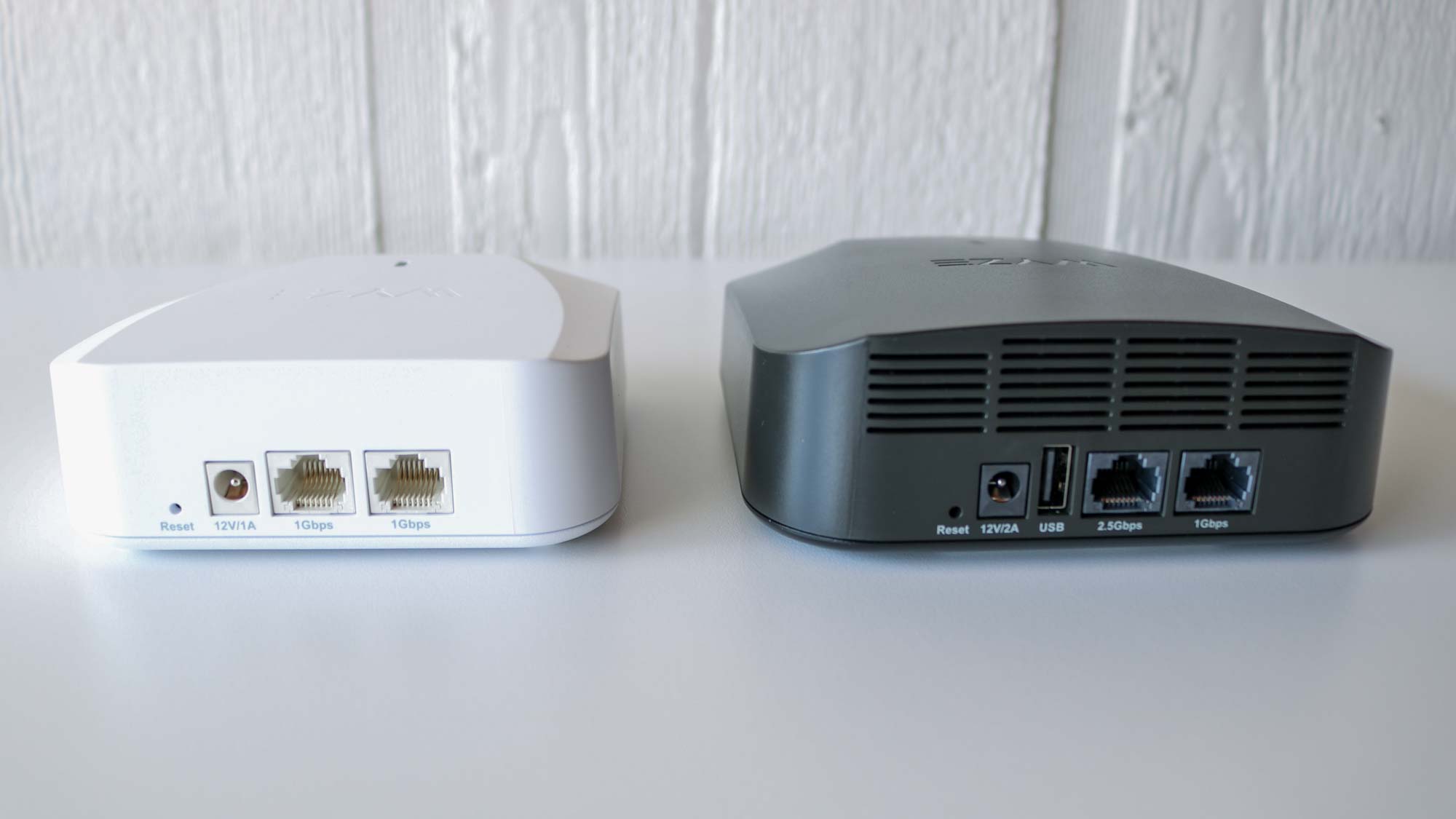
Ports: Though improved wireless connectivity is the main thing you want from a mesh Wi-Fi system, you’ll also want to think about wired connections. Ethernet offers faster connectivity for devices like computers, game consoles and smart TVs that use more bandwidth and USB ports are useful for attaching older printers or storage to your network. However, not every mesh system has several physical ports, so make sure you get a system that will meet your needs. Keep in mind though, you can always use an Ethernet switch to easily add more ports to your mesh router.
Price: For many shoppers, it all comes down to value – which mesh Wi-Fi system provides the most bang for your buck. So we also consider what you really get for your money, considering which features are worthwhile and how any given product compares with other devices from competing manufacturers.
Mesh routers range in price from $120 to $400 or more. As mesh systems use multiple devices, you can generally buy a complete mesh Wi-Fi system as a two or three-unit package. However, you can also buy individual satellite units to extend a mesh network to cover a larger area. Individual units often sell for $100 to $200, though specialized units that offer additional functionality may cost more.
The products on this list are our top picks as they are the best mesh Wi-Fi systems you can buy right now. Whether it’s a question of performance, value or features, we call out the products that deliver the best value and explain why they might be the perfect fit for your home.
Check out all of our home networking coverage:
Best Wi-Fi routers | Best Wi-Fi 6 routers | Best Wi-Fi 7 routers | Best gaming routers | Best Wi-Fi extenders | Best powerline extenders
Sign up to get the BEST of Tom's Guide direct to your inbox.
Get instant access to breaking news, the hottest reviews, great deals and helpful tips.

Anthony Spadafora is the managing editor for security and home office furniture at Tom’s Guide where he covers everything from data breaches to password managers and the best way to cover your whole home or business with Wi-Fi. He also reviews standing desks, office chairs and other home office accessories with a penchant for building desk setups. Before joining the team, Anthony wrote for ITProPortal while living in Korea and later for TechRadar Pro after moving back to the US. Based in Houston, Texas, when he’s not writing Anthony can be found tinkering with PCs and game consoles, managing cables and upgrading his smart home.
